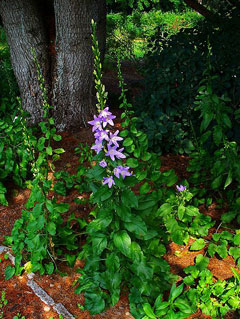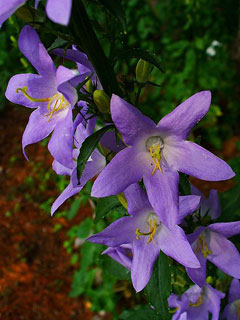 |
|
http://commons.wikimedia.org/wiki/File:Campanula_pyramidalis_001.jpg |
 |
|
Translate this page:
Summary
Physical Characteristics

 Campanula_pyramidalis is a PERENNIAL growing to 1.5 m (5ft) by 0.5 m (1ft 8in).
Campanula_pyramidalis is a PERENNIAL growing to 1.5 m (5ft) by 0.5 m (1ft 8in).
See above for USDA hardiness. It is hardy to UK zone 8 and is not frost tender. It is in flower from July to August. The species is hermaphrodite (has both male and female organs). The plant is self-fertile.
Suitable for: light (sandy), medium (loamy) and heavy (clay) soils and prefers well-drained soil. Suitable pH: mildly acid, neutral and basic (mildly alkaline) soils. It can grow in semi-shade (light woodland) or no shade. It prefers moist soil.
UK Hardiness Map
US Hardiness Map
Synonyms
Plant Habitats
Edible Uses
Leaves - raw or cooked. A mild slightly sweet flavour[K]. Flowers - raw. A nice decorative addition to salads, the flowers have a pleasant sweet flavour[K].
References More on Edible Uses
Medicinal Uses
Plants For A Future can not take any responsibility for any adverse effects from the use of plants. Always seek advice from a professional before using a plant medicinally.
None known
References More on Medicinal Uses
The Bookshop: Edible Plant Books
Our Latest books on Perennial Plants For Food Forests and Permaculture Gardens in paperback or digital formats.

Edible Tropical Plants
Food Forest Plants for Hotter Conditions: 250+ Plants For Tropical Food Forests & Permaculture Gardens.
More

Edible Temperate Plants
Plants for Your Food Forest: 500 Plants for Temperate Food Forests & Permaculture Gardens.
More

More Books
PFAF have eight books available in paperback and digital formats. Browse the shop for more information.
Shop Now
Other Uses
References More on Other Uses
Cultivation details
Succeeds in most fertile well-drained soils[233], though it prefers a moist but very well-drained rich sandy loam and a neutral or alkaline soil[1, 200]. Plants are impatient of drought and of too much sunshine, growing best in a shady position[221, 271]. This species is not hardy in the colder areas of the country, it tolerates temperatures down to between -5 and -10°c[200]. Plants are best grown in a greenhouse in Britain, they are seldom fully happy outdoors and do not usually open their flowers properly[221]. Plants usually set seed freely and will often self-sow in the garden[271]. The species in this genus do not often hybridize and so seed can generally be relied upon to come true[221]. The plants are self-fertile[221]. A short-lived perennial[200], in the garden it is best grown from seed as a biennial or propagated each year from the non-flowering side rosettes[221]. The woody roots will usually persist for some years so long as the plant is in a well-drained soil and a sunny position[233]. Except in the most sheltered of positions, the tall flowering stems require staking in order to stop them snapping at the base in high winds[271]. This species is closely related to C. versicolor. There are several named forms selected for their ornamental value[200]. The cultivar 'Alba' is used as an altar flower in its native regions, this cultivar demands an especially well-drained soil and is less hardy than the type[200]. Members of this genus are rarely if ever troubled by browsing deer[233].
References Carbon Farming Information and Carbon Sequestration Information
Temperature Converter
Type a value in the Celsius field to convert the value to Fahrenheit:
Fahrenheit:
The PFAF Bookshop
Plants For A Future have a number of books available in paperback and digital form. Book titles include Edible Plants, Edible Perennials, Edible Trees,Edible Shrubs, Woodland Gardening, and Temperate Food Forest Plants. Our new book is Food Forest Plants For Hotter Conditions (Tropical and Sub-Tropical).
Shop Now
Plant Propagation
Seed - surface sow spring in a cold frame. The seed usually germinates in 2 - 4 weeks at 18°c. It is best to sow the seed as soon as it is ripe in the autumn in a greenhouse in order to give the plant a long season of growth, otherwise sow it in late winter[221]. When they are large enough to handle, prick the seedlings out into individual pots and plant them out into their permanent positions in the summer. Basal cuttings in spring. Harvest the shoots when they are about 10 - 15cm long with plenty of underground stem. Pot them up into individual pots and keep them in light shade in a cold frame or greenhouse until they are rooting well. Plant them out in the summer. Division in spring or autumn[200]. The plant has a thick fleshy root with a number of crowns. Whilst this can be divided if great care is taken not to damage the root, it is not really recommended because the divisions take a long time to become established[221].
Other Names
If available other names are mentioned here
Native Plant Search
Search over 900 plants ideal for food forests and permaculture gardens. Filter to search native plants to your area. The plants selected are the plants in our book 'Plants For Your Food Forest: 500 Plants for Temperate Food Forests and Permaculture Gardens, as well as plants chosen for our forthcoming related books for Tropical/Hot Wet Climates and Mediterranean/Hot Dry Climates. Native Plant Search
Found In
Countries where the plant has been found are listed here if the information is available
Weed Potential
Right plant wrong place. We are currently updating this section.
Please note that a plant may be invasive in one area but may not in your area so it’s worth checking.
Conservation Status
IUCN Red List of Threatened Plants Status :

Growth: S = slow M = medium F = fast. Soil: L = light (sandy) M = medium H = heavy (clay). pH: A = acid N = neutral B = basic (alkaline). Shade: F = full shade S = semi-shade N = no shade. Moisture: D = dry M = Moist We = wet Wa = water.

Expert comment
Author
L.
Botanical References
200
Links / References
For a list of references used on this page please go here
Readers comment
© 2010, Plants For A Future. Plants For A Future is a charitable company limited by guarantee, registered in England and Wales. Charity No. 1057719, Company No. 3204567.